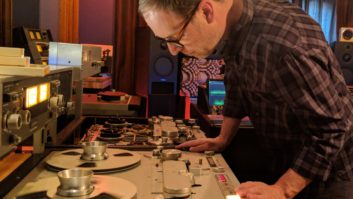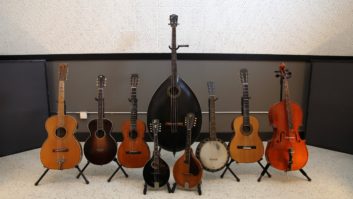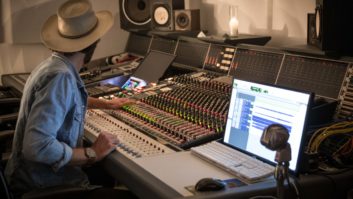As college life for Stephen Marsh abruptly ended, his career in audio began. “What else do you do when you get kicked out of school?” Marsh offers with a laugh. Suddenly having the flexibility to move, he joined a friend headed to Los Angeles to music school, ultimately finding an available runner position at Sony Music Studios on a bulletin board. His work ethic ultimately convinced the studio to keep him around: “I just kept coming back every day.”
After a month and a half, the studio began paying him—ideal timing, as just a few months later, Sony’s night mastering engineer left, fast-forwarding Marsh’s career in mastering significantly. He was serving as a second engineer to David Mitson, where Marsh honed his skills and learned the ropes for the next seven years.
“One of the unique things about working at a label studio was, though you have your own clients, all of the work that every other mastering engineer did around the country—and around the globe—flowed through your room, too,” Marsh explains. “So I’d sit there, listening to an album 12 times over that Bernie Grundman just mastered. The next night, it would be an album that Ted Jensen mastered—again, listening to it 12 times in a row. Through that, I really gained an understanding of how different engineers approached mastering sonically.”
Marsh cites Mitson for mentoring him in a positive, empowering way. “I was very fortunate for coming up under a guy who never tried to teach me to do what he did,” Marsh offers. “He taught me how the tools worked and what the process and the job was, then let me find my own way. When he retired, it meant his clients didn’t naturally just come to me; I had to find that group of people who dug what I did and what I brought to the table. Having done this now for 22 years, getting work has become a process of finding out which friends are working on records this year, and we do them. I really like the community aspect of what I do.”
Striking out on his own after Sony, Marsh has now been an independent mastering engineer for the past 15 years. And, as many tend to do in Southern California, Marsh has moved his mastering room nine times since then. As such, he’s gained a practical education in acoustic treatment, learning a lot about treating his own space along the way.
“I’ve had an Augsperger room, and the first mastering room I worked in at Sony was the first mastering room Vincent van Haaff designed. I’ve worked in small rooms, office rooms, a converted broadcast studio once, a converted home theater—a lot of different rooms. When you live in Los Angeles, there are a few inevitabilities, and one of those is moving. Every few years, everybody moves—markets change, rates changes, home values change. For the reasons people move, it just seems it happens at a more accelerated rate in L.A. So every time I would build a studio, I ended up building space that would ultimately be for someone else.”
Marsh began researching products that would allow him to treat existing rooms without doing a build-out, utilizing fully modular acoustic treatment tools. “Ideally, I would just need to find the right space with the right dimensions, ceiling height, and so on,” he explains. “And that’s where GIK Acoustics came in.”
Marsh Mastering has moved multiple times into a variety of rooms, using surface-mount acoustic treatments from GIK Acoustics to provide consistency.

Looking at companies that provided surface-mount acoustic treatments, GIK Acoustics’ materials stood out for several reasons. “I found that GIK brought together the whole package, including design,” Marsh explains. “I reached out to Glenn [Kuras, GIK Acoustics founder], who was ready to talk about a studio in which I could take everything with me. I wanted a full-treatment package where, if I found another room of approximately the same dimensions, I could pick it up and drop it in. And I’ve done that once already.”
As a result, the array of GIK products Kuras and Marsh put together for another space works seamlessly well in the new room. “It worked, and I was really impressed,” Marsh continues. “We packed up all the acoustics, brought it down here, and—because the new room was larger than the last one—we built it slightly back down to match the dimensions of the last room. We did one tweak, moving one diffusor and changed the trapping just a bit because the flooring was different. But it just worked. It was awesome, and it saved me countless thousands of dollars.”
Marsh carefully hones his gear collection, as his equipment list reflects many years of wise purchases. “Starting out, I had one Sontec [MES-430B] EQ, one Sontec DRC-202,” he explains. “That was the chain, with Apogee converters. “I spent the first decade of my career adding gear, and the last decade taking gear out. I think it’s because of changing flavors, and we were doing a different kind of mastering in the ‘90s—I grew up through the modern version of ‘the level wars,’ or the ‘let’s make this CD really loud’ era. Mastering has come full circle in that time, back to dynamic range, or ‘making records sound good again.’”
Today, Marsh’s main analog chain includes the GML Model 9500 and EAR 825q mastering equalizers with Maselec dynamics processing, select newer products such as A-Designs’ HAMMER2 EQ and a pair of custom TK Audio TK-Lizer equalizers, among others; Marsh claims to use just a bit of limiting, in general. Though he’s not a big plug-in user, he uses iZotope RX daily. “I’ve never come up with a plug-in chain that I think is as reliable as analog, so I’m still tied to analog gear.” Marsh Mastering also relies upon Bryston-powered PMC main monitors and a Merging Technologies Hapi-Premium interfaced Pyramix workstation as the primary DAW. Additionally, a pair of carefully restored ATR-104s and a Studer A80 tape machine are available for analog playback.
Regarding monitoring, Marsh used Dunlavy speakers up until his move to PMC. “I fell in love with PMCs, and I’m on my second set now,” he explains. “Now it looks like I’m going to upgrade to a new set; I heard the PMC MB3 at NAMM and I’m pretty well sold—they sound so good.”
Marsh Mastering
http://www.marshmastering.com/





